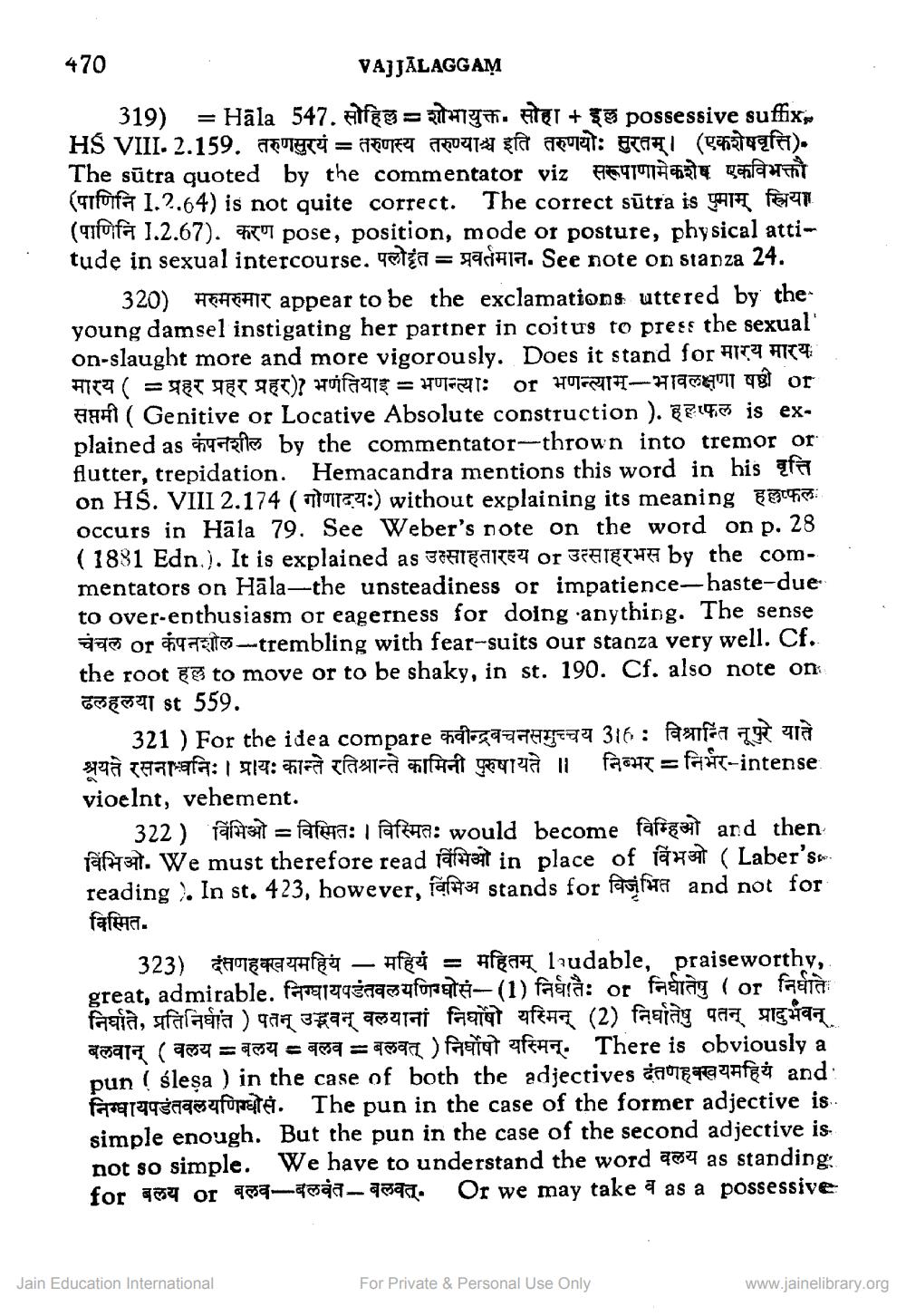________________
470
VAJJĀLAGGAM
319) = Hala 547. सोहिल = शोभायुक्त. सोहा + इल possessive suffixn HS VIII. 2.159. तरुणसुरयं = तरुणस्य तरुण्याश्च इति तरुणयोः सुरतम्। (एकशेषवृत्ति). The sātra quoted by the commentator viz सरूपाणामेकशेष एकविभक्तो (पाणिनि I.2.64) is not quite correct. The correct sutra is पुमाम् स्त्रिया (पाणिनि 1.2.67). करण pose, position, mode or posture, physical attitude in sexual intercourse. पलोट्टत = प्रवर्तमान. See note on stanza 24.
320) HEHEHTC appear to be the exclamations uttered by the young damsel instigating her partner in coitus to press the sexual on-slaught more and more vigorously. Does it stand for मारय मारयः मारय ( प्रहर प्रहर प्रहर? भणंतियाई -भणन्त्याः or भणन्त्याम्-भावलक्षणा षष्ठी or सप्तमी ( Genitive or Locative Absolute construction ). हलफल is explained as netails by the commentator-thrown into tremor or flutter, trepidation. Hemacandra mentions this word in his qfar on HS. VIII 2.174 ( गोणादयः) without explaining its meaning हल्लप्फलः occurs in Hala 79. See Weber's note on the word on p.28 (1881 Edn). It is explained as उत्साहतारल्य or उत्साहरभस by the com
mentators on Hala-the unsteadiness or impatience-haste-duer to over-enthusiasm or eagerness for doing anything. The sense चंचल or कंपनशील-trembling with fear-suits our stanza very well. Cf. the root हल to move or to be shaky, in st. 190. Cf. also note on ढलहलया st 559.
321 ) For the idea compare कवीन्द्रबचनसमुच्चय 316 : विश्रान्ति नूपुरे याते श्रूयते रसनावनिः। प्रायः कान्ते रतिश्रान्ते कामिनी पुरुषायते ॥ निब्भर = निर्भर-intense vioelnt, vehement.
322) विभिओ = विस्मितः । विस्मित: would become विम्हिओ and then विभिओ. We must therefore read विभिओ in place of विभओ ( Laber'ss.. reading . In st. 423, however, विमिअ stands for विजेंभित and not for विस्मित.
323) दंतणहक्खयमहियं - महियं = महितम् 17udable, praiseworthy, great, admirable. निग्यायपडंतवलयणिग्घोसं-(1) निघतैः or निधीतेषु ( or निधोते निर्घाते, प्रतिनिधीत ) पतन् उद्भवन् वलयानां निघोषो यस्मिन् (2) निर्घातेषु पतन् प्रादुर्भवन् बलवान् ( वलय = बलय - बलव = बलवत् ) निर्घोषो यस्मिन्. There is obviously a pun ! śleşa ) in the case of both the adjectives aura@gAfgå and: निग्धायपडंतवलयणिग्धोसं. The pun in the case of the former adjective is.. simple enough. But the pun in the case of the second adjective is not so simple. We have to understand the word 204 as standing: for बलय or बलव-बलवंत- बलवत्. Or we may take व as a possessive
Jain Education International
For Private & Personal Use Only
www.jainelibrary.org




